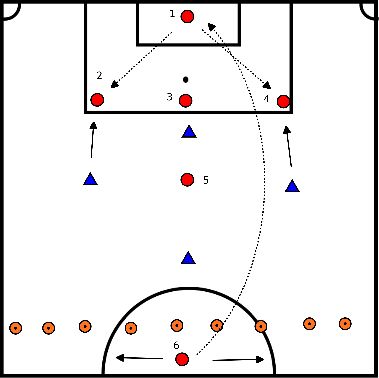Soccer drills for technique passing
- Exercise A: Overpass ball through gate right and left legged.
Emphasis on stance leg dropping slightly through knee and kick leg hitting ball in the middle.
Keep body straight, do not hang. - Exercise B: instep kick.
- Exercise C: dribble around the pawn, first inside foot right and left, then try outside foot.
Speed is not necessary, prefer to hit the ball every step. - Players A and B change after 5 minutes, if all 3 have been to B then A & B change to C.
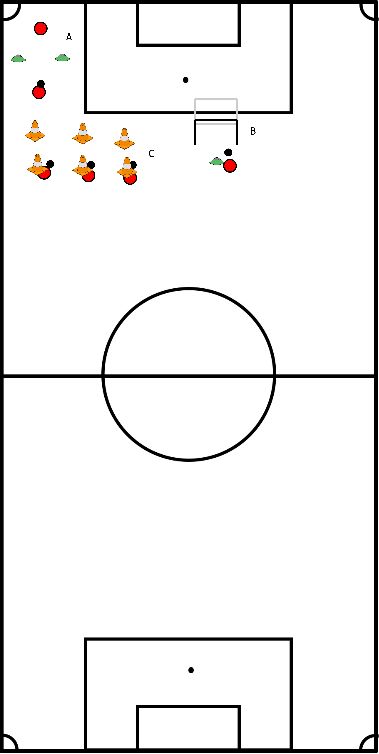
To maintain speed, position B is manned by 2 players.
- Player A sprints toward the first pole.
- Taps this pole, turns around and accelerates to pole 2.
- Turns briefly around pole 2 and jumps over the fence.
- Player B plays a tight ball into the run of player A at the moment of jumping.
- Player A lays one well and finishes in mini goal.
Player A picks up ball and joins B. Player B becomes player A.
Mirroring possible from 12+ players.
Mirroring possible from 12+ players.
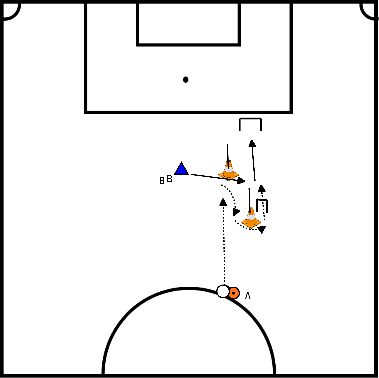
- Exercise A: passing the ball through right and left legged gates
- Emphasis on stance leg dropping slightly through knee
- Hitting the ball in the middle
- Keep body straight, do not hang up
- Exercise B: instep kick.
- Exercise C: dribble around the pawn
- First inside foot right and left
- Then try outside foot
- No need for speed, preferably hitting the ball every step
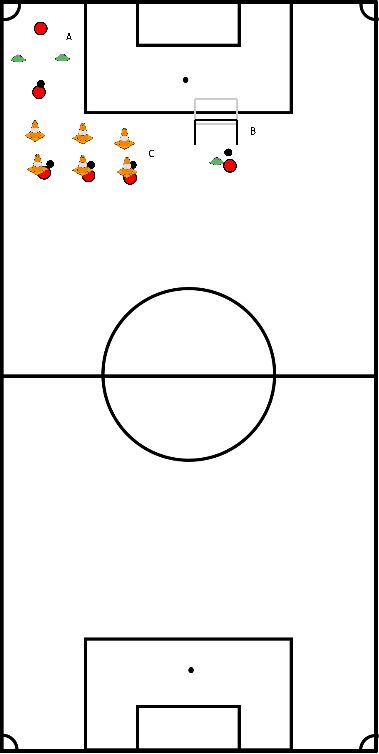
- Pass and dribble
- Player follows the ball
- Pass correctly and pay attention to 1 x hit
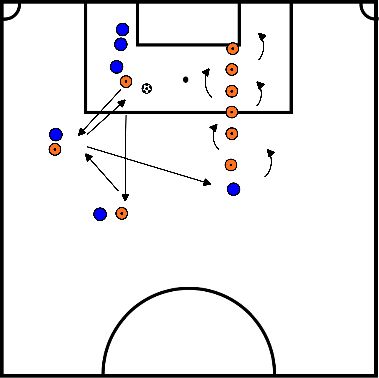
Goal:
- Improve building from behind
Contents:
- Improve building from behind
Contents:
- A does for action and asks for the ball from B
- B plays ball to A
- A plays ball to C
- D starts to run forward
- C passes ball in the run to D
- D finishes on the small goalmouth
- A = 6
- B = 3
- C = 3-4
- D = 2
Coaching:
- Communicate with your players
- Keep moving continuously
- See where your fellow players are standing
- Run on time
CAUTION!!!
Exercise is done in two groups so there is no need to stand still for long periods of time!
- Communicate with your players
- Keep moving continuously
- See where your fellow players are standing
- Run on time
CAUTION!!!
Exercise is done in two groups so there is no need to stand still for long periods of time!
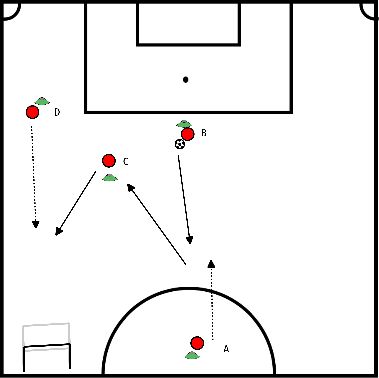
- Distances:
- Rectangle of 15 by 5 meters.
- Pawns B and C 5 meters apart.
- Both 2.5 meters from side and 5 meters from A and D.
- Duration: 10 min.
- After 5 min change direction
Explanation:
- A plays into B
- B drops the ball to C
- C passes to D
- The moment the ball reaches D, A has to be there to make the handball.
- D bounces to A and runs straight through to be played in again.
- A rebounds to D and D rebounds to E.
- E takes ball to starting point.
- Running lines: A becomes B, B becomes C etc.
Points of attention:
- Tight balls by hitting ball in heart, body slightly over ball.
- B must drop the ball on C slightly to outside so that there is a free pass line to D.
- A must time that she/he is present at the right time for the handball with D.
- If she/he is too early and has to wait too long it means in the match that there is opponent in her/his back.
- Is she/he too late D has to wait it means in the match that the opponent can put pressure on D.
- To maintain concentration make sure that at point A the ball is not played until everyone is in place.
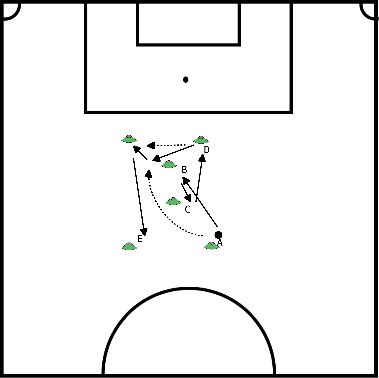
Warming up 3 exercises +- 8 min
- 1st 6 meter sprint next to the field.
- get them ready 1 leg in front 1 behind
- hands next to the body
- each 3x
- 2nd exercise stand on 1 leg other leg bent backwards 20 seconds hold then other leg.
- If this is difficult, you do a round per leg.
- 3rd exercise is with ball on upper leg-> ball on foot and catch both cases.
Dribbling exercises. The goals are 1 meter big
- Dribble through as many goals as possible within a minute.
- They can do this all at the same time.
- But they should not go through a goal at the same time. Make sure they do not wait for each other at a goal then they have to find another goal. If they wait too often, add 2 more goals.
- Dribble 1 ball with pairs. Score by kicking the ball through the goal to your partner.
- Practice for a few minutes, then play. Who scores the most goals within a minute?
- Goals dribbling waste rounds.
- In box have ball dribble on yes sign have ball stop in goal.
- Last one falls off each time until there is 1 winner.
- In this exercise, have the players first dribble and kick the ball into the goal without dropping out.
- Kicking exercise
- 2 goals and pylons at 5 meters, 8 meters and 10 meters. Shoot into goal via inside foot.
- Then hit 1 pylon to the back.
- Make sure the stand leg is next to the ball not against it and pointing towards the goal.
- Make sure the shooting leg is brought to the back and swung straight ahead.
- Correct if they are not doing this correctly.
- Remaining time; party form
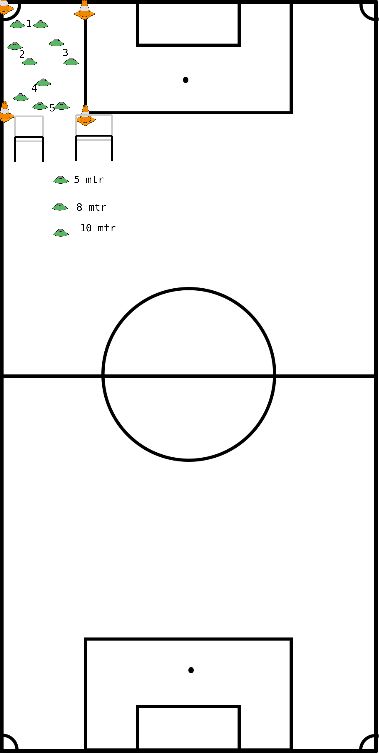
- One ball per triplet
- Start with a distance of about 15 meters
- Two players on one side and one player on the other side.
- One of the players on the side with two plays the ball to the player on the other side, this player takes the ball and plays it to the player on the other side, and so on.
- Practice both with your good and lesser leg.
Variations:
- After a few minutes increase the distance, about 20, 25, 30 meters, at the 30 meters practice a lobster kick.
1st exercise:
- Player A plays the ball in to B and runs to B's position.
- Player B stands open turned, takes it and passes it to Player C and so on.
- Point of attention playing in:
- the ball must be hit in the middle so that it stays low.
- The correct technique for this is to lift your shooting leg slightly.
- Passing point:
- The player who accepts the ball should not be facing the ball with his or her body, but turned "open". You create this by positioning your body towards the player you are passing to and with your eyes on the ball.
- Playing around clockwise, the ball is taken on with the left and I play on with the right.
- In the other direction take on with the right and play on with the left.
- If you notice it's too easy, first increase the pace. Then to make it more difficult you can take out the assumption and they have to pass the ball directly.
2nd exercise:
- Player B asks for the ball.
- Player A plays into player B.
- Then B then drops the ball to player A after which he passes it back to player C.
- Player C then drops it to player B and then player B plays it diagonally to player D and so on.
Points of attention:
- The player who plays the ball in must move on after the play-in so that he can ask for the ball, in the middle, between the pawns
- Not further because then the effect is gone with the cross pass.
- The player who rebounds runs around his own pawn to ask for the ball again in the middle.
- This player must make the correct turn when rebounding so that he keeps his eyes on the ball.
- His turn should be short toward the box and not off the play.
In both drills after 8 minutes, change directions of play.
Clockwise passes with right leg, counterclockwise passes with left leg.
Clockwise passes with right leg, counterclockwise passes with left leg.
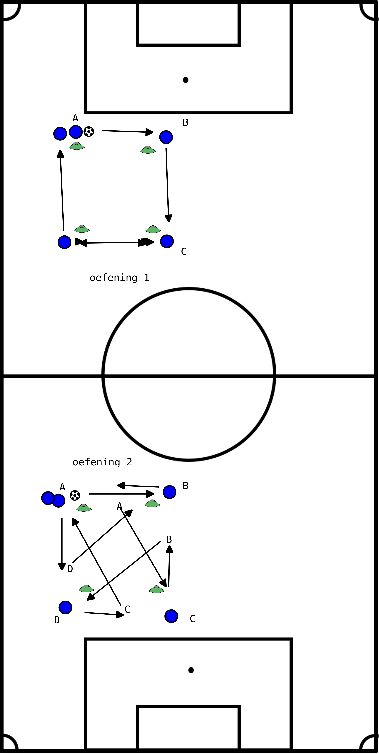
Square with 5 players or triangle with 4 players, at a distance of about 15 meters:
- Player at hat with 2 players starts.
- Plays the ball in on the right side and runs after his ball to the other hat.
- The player receiving the ball turns open and takes the ball well so that he can pass it in to the next player.
- Practice both counterclockwise and clockwise.
3 or 4 players per set:
- Two hats spaced about 15 yards apart.
- 2 players on one side and 1 or 2 players on the other side.
- 1 of the 2 players plays the ball to the other side and continues halfway to the other hat.
- The player on the other side takes the ball and plays it in to the player who ran halfway.
- This player rebounds the ball and continues to the other hat.
- The player who receives the ball back takes the ball and plays it to the player on the side where it was started.
- Running through like this.
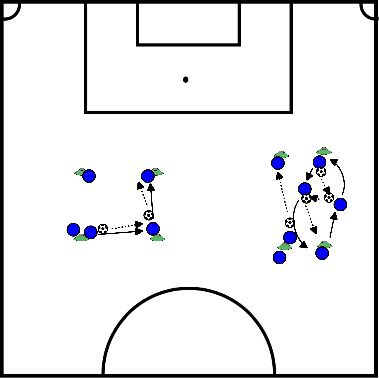
1st exercise:
- Player A plays the ball in to B and runs to B's position.
- Player B is open turned takes it and passes it to Player C and so on.
- Focal point 1 playing in: the ball must be hit in the middle so that it stays low.
- The correct technique for this is to lift your shooting leg slightly.
- Focal point 2 receiving: The player who has to receive the ball should not be facing the ball but rather, as they say, turned open. You create this by positioning your body towards the player you have to pass to and your face is facing the ball. Playing the ball around clockwise, the ball is taken on with the left and I play on with the right. other way round take on with the right and play on with the left.
- If you notice that it is too easy, first increase the tempo. If that also proves too easy then you take out the takeover and they have to pass the ball directly.
2nd exercise:
- Player B asks for the ball, player A plays into player B. Then B drops the ball to player A who then passes it on to player C.
- Player C then drops it to player B and then player B plays it diagonally to player D and so on.
Points of attention:
- The player who plays the ball in must move on after playing in so that he asks for the ball in the middle between the pawns
- Not further because then the cross pass effect is gone.
- The player who bounces the ball back runs around his own pawn to ask for the ball again in the middle.
- It is imperative that this player makes the correct turn when rebounding so that he keeps his eyes on the ball.
- His turn should be short toward the box and not off the play.
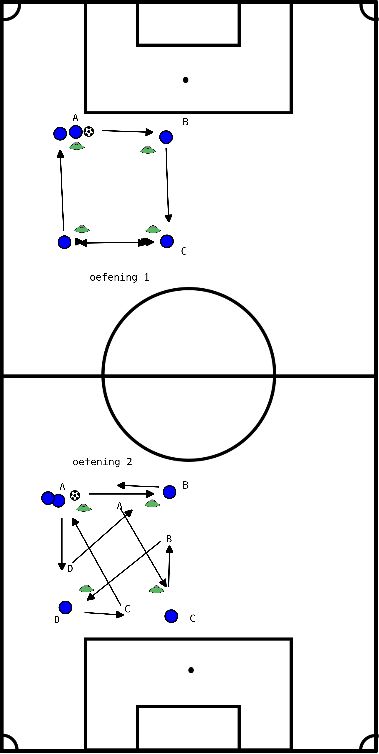
Goal:
Defenders try to intercept the ball quickly:
Exercise:
Defenders try to intercept the ball quickly:
Exercise:
- Play starts at number 6 who kicks to goalkeeper
- Goalkeeper then plays directly to 2 or 4
- At the moment 2 or 4 is played to, the blue team starts pressing and tries to prevent the depth pass
- The red team can "score" by passing a depth pass to number 6, who can move all over the width in his defined zone
- The blue team can score in the big goal
Coaching:
- 2-5 from defending side direct pressure on the ball
- 9 defending directly covers to line the ball
- 4 defending direct pass on number 5 attacking side.
- 6 attackers moving with ball and joining the game
